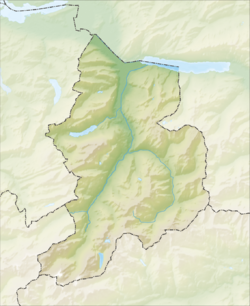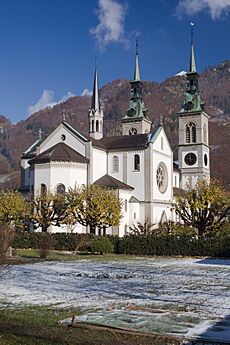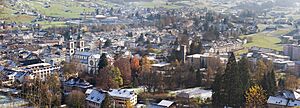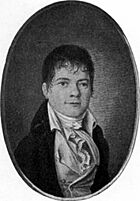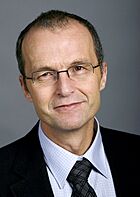Glarus facts for kids
Quick facts for kids
Glarus
|
||
|---|---|---|
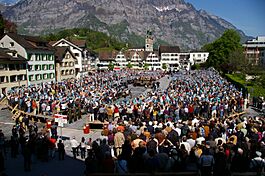
Landsgemeinde in Glarus, 2009
|
||
|
||
| Country | Switzerland | |
| Canton | Glarus | |
| District | n.a. | |
| Area | ||
| • Total | 103.67 km2 (40.03 sq mi) | |
| Elevation
(Stadtkirche Glarus)
|
472 m (1,549 ft) | |
| Population
(Dec 2020 )
|
||
| • Total | 12,539 | |
| • Density | 120.951/km2 (313.262/sq mi) | |
| Demonym(s) | German: Glarner(in) | |
| Postal code |
8750, 8754, 8755
|
|
| Localities | Glarus, Netstal, Ennetbühls, Ennenda, Riedern, Hinter-Klöntal, Richisau, Klöntal | |
| Surrounded by | Glarus Nord, Glarus Süd, Muotathal (SZ), Innerthal (SZ) | |
| Twin towns | Wiesbaden-Biebrich (Germany) | |
Glarus is the capital city of the canton of Glarus in Switzerland. It's a beautiful town located on the Linth river. The town is surrounded by mountains like the Glärnisch to the west and the Schilt to the east.
Glarus is known for its industries, including wood, textiles, plastics, and printing. The most famous building in the city is the neo-Romanesque city church. Since 2011, the towns of Ennenda, Netstal, and Riedern have become part of the Glarus municipality.
Contents
History of Glarus
Glarus was first mentioned in old Latin writings around the early 800s. Later, in 1178, it was called "Glarus" in German.
For a long time, Glarus was controlled by the Säckingen Abbey. This changed in 1395 when the Glarus valley became independent. In 1419, Glarus became the main city of the Linth valley. Over the 1700s and 1800s, the area started to become more industrial, meaning more factories and businesses opened.
The Reformation and Religious Changes
A famous leader of the Reformation in Switzerland, Huldrych Zwingli, worked in Glarus starting around 1506. He was a priest here for ten years. During this time, Zwingli became involved in politics because Swiss soldiers were often hired as mercenaries by other countries.
Zwingli supported the Pope, and even received a yearly payment from him. He joined several military campaigns in Italy. However, after a big defeat for the Swiss in 1515, people in Glarus started to favor the French instead of the Pope. This made Zwingli's position difficult, so he moved away.
Even though Zwingli had preached in Glarus, the town stayed mostly Catholic. But after a conflict in 1531, both Catholics and Protestants were allowed to worship in the town. This led to both groups using the same church! By the 1700s, they shared the church but had separate organs and even separate church groups.
French Influence and New Beginnings
In 1798, French armies invaded Switzerland. Glarus then became the capital of a new area called the Canton of Linth. However, the new leaders found it hard to manage things in Glarus. They even moved the capital to another town for a short time.
In 1803, the Canton of Linth was dissolved, and Glarus became the capital of the smaller Canton of Glarus, which is what it is today.
Modern Developments
The railway arrived in Glarus in 1859, connecting it to other towns. This made travel and trade much easier.
In 1845, some people from Glarus decided to move to North America to find new land. They settled in a place called New Glarus, Wisconsin in the United States. This town still has strong Swiss roots and a close connection with Glarus.
A huge fire destroyed about two-thirds of Glarus on May 10-11, 1861. Strong winds helped the fire spread quickly. After the fire, the town was rebuilt with a new, planned layout.
In 1864, Glarus introduced the first labor law in Europe to protect workers. This law made it illegal for people to work more than 12 hours a day. This was a very important step for workers' rights!
Geography
Glarus is located in a wide valley floor between the Glärnisch mountain and the Linth river.
Before 2011, the area of Glarus was about 69.2 square kilometers. A good part of this land was used for farming (23%) or covered by forests (31.4%). The rest was settled areas like buildings and roads, or non-productive land like mountains.
After the nearby towns joined Glarus in 2011, the municipality became much larger. Now, about 26.3% of the land is used for farming, and 34.3% is covered by forests.
Demographics
Glarus has a population of about 12,600 people. Around 25% of the people living in Glarus are foreign nationals.
Children and teenagers (up to 19 years old) make up about 20.6% of the population. Adults (20-64 years old) are 61.1%, and seniors (over 64 years old) are 18.3%.
Most people in Glarus speak German (86%). Italian is the second most common language (4.8%), followed by Albanian (2.6%).
Historical Population
Here's how the population of Glarus has changed over time:
| year | population | Swiss Citizens | % German Speaking | % Protestant | % Roman Catholic |
|---|---|---|---|---|---|
| 1554 | ca. 1,550 | ||||
| 1682 | ca. 1,200 | ||||
| 1777 | ca. 2,400 | ||||
| 1837 | 4,094 | ||||
| 1850 | 4,082 | 3,960 | 86.0% | 14.0% | |
| 1870 | 5,485 | 5,204 | 77.7% | 22.6% | |
| 1888 | 5,357 | 4,968 | 98.1% | 71.6% | 28.0% |
| 1900 | 4,877 | 4,424 | 97.5% | 74.2% | 25.6% |
| 1910 | 5,123 | 4,471 | 94.8% | 70.8% | 28.7% |
| 1930 | 5,269 | 4,858 | 97.7% | 70.5% | 29.2% |
| 1950 | 5,724 | 5,376 | 96.2% | 68.0% | 31.4% |
| 1970 | 6,189 | 5,215 | 86.9% | 60.5% | 38.9% |
| 1990 | 5,728 | 4,723 | 86.1% | 51.9% | 42.4% |
| 2000 | 5,556 | 4,379 | 86.0% | 45.4% | 37.7% |
Economy and Education
In 2012, over 8,000 people worked in Glarus. Many jobs were in the "tertiary sector," which includes services like shops, offices, and schools. The "secondary sector" (factories and manufacturing) and "primary sector" (farming) also provided jobs.
Most adults in Glarus (between 25 and 64 years old) have completed high school or even higher education like university.
Transport
Glarus has its own railway station, which is part of the line connecting Ziegelbrücke to Linthal. Trains run every hour, connecting Glarus to bigger cities like Zürich and Rapperswil. The towns of Ennenda and Netstal, now part of Glarus, also have railway stations.
Climate
Glarus gets a good amount of rain each year, about 1494 mm on average. The wettest month is usually July. The driest month is February. The weather in Glarus is influenced by its mountain location.
| Climate data for Glarus (517m a.s.l., reference period 1991–2020) | |||||||||||||
|---|---|---|---|---|---|---|---|---|---|---|---|---|---|
| Month | Jan | Feb | Mar | Apr | May | Jun | Jul | Aug | Sep | Oct | Nov | Dec | Year |
| Mean daily maximum °C (°F) | 3.2 (37.8) |
4.8 (40.6) |
9.9 (49.8) |
14.8 (58.6) |
19.0 (66.2) |
22.2 (72.0) |
23.8 (74.8) |
23.2 (73.8) |
18.6 (65.5) |
14.1 (57.4) |
8.1 (46.6) |
3.9 (39.0) |
13.8 (56.8) |
| Daily mean °C (°F) | 0.0 (32.0) |
1.0 (33.8) |
5.2 (41.4) |
9.5 (49.1) |
13.5 (56.3) |
16.7 (62.1) |
18.3 (64.9) |
17.9 (64.2) |
14.0 (57.2) |
9.8 (49.6) |
4.6 (40.3) |
0.9 (33.6) |
9.3 (48.7) |
| Mean daily minimum °C (°F) | −3.0 (26.6) |
−2.4 (27.7) |
1.0 (33.8) |
4.4 (39.9) |
8.4 (47.1) |
11.9 (53.4) |
13.6 (56.5) |
13.5 (56.3) |
10.0 (50.0) |
6.1 (43.0) |
1.5 (34.7) |
−1.9 (28.6) |
5.3 (41.5) |
| Average precipitation mm (inches) | 92 (3.6) |
80 (3.1) |
99 (3.9) |
93 (3.7) |
132 (5.2) |
167 (6.6) |
193 (7.6) |
192 (7.6) |
131 (5.2) |
104 (4.1) |
101 (4.0) |
110 (4.3) |
1,494 (58.8) |
| Average snowfall cm (inches) | 32.7 (12.9) |
29.9 (11.8) |
14.4 (5.7) |
0.5 (0.2) |
0.0 (0.0) |
0.0 (0.0) |
0.0 (0.0) |
0.0 (0.0) |
0.0 (0.0) |
0.7 (0.3) |
10.9 (4.3) |
31.5 (12.4) |
120.6 (47.5) |
| Average precipitation days (≥ 1.0 mm) | 10.7 | 9.5 | 11.3 | 11.2 | 13.5 | 14.3 | 14.8 | 14.3 | 11.6 | 10.0 | 10.2 | 10.8 | 142.2 |
| Average snowy days (≥ 1.0 cm) | 5.7 | 4.9 | 3.7 | 0.3 | 0.0 | 0.0 | 0.0 | 0.0 | 0.0 | 0.1 | 1.8 | 5.1 | 21.6 |
| Average relative humidity (%) | 82 | 77 | 72 | 67 | 71 | 74 | 76 | 78 | 81 | 82 | 82 | 83 | 77 |
| Mean monthly sunshine hours | 62 | 71 | 96 | 137 | 156 | 164 | 175 | 163 | 109 | 86 | 60 | 54 | 1,331 |
| Percent possible sunshine | 44 | 48 | 50 | 49 | 45 | 46 | 49 | 51 | 53 | 50 | 42 | 39 | 48 |
| Source: MeteoSwiss (snow 1981–2010) | |||||||||||||
Gallery
International Connections
Glarus has special connections with other towns around the world, called "twin towns" or "sister cities." These connections help people from different places learn about each other's cultures.
Twin Towns
- Wiesbaden-Biebrich in Germany
- New Glarus, Wisconsin in the United States, a town founded by people from Glarus!
Notable People from Glarus
Many interesting people have come from Glarus:
- Anna Göldi (1734 – 1782 in Glarus) was the last person to be put to death for witchcraft in Europe.
- Heinrich Hössli (1784 in Glarus – 1864) was a Swiss hat maker and writer.
- Johann Jakob von Tschudi (1818 in Glarus – 1889) was a Swiss scientist, explorer, and diplomat.
- Johann Jakob Blumer (1819 in Glarus – 1875) was a Swiss statesman, meaning he was an important political leader.
- Franz Joseph Untersee (1858 in Glarus - 1927) was a Swiss-American architect who designed many churches in the US.
- Roslï Näf (1911 in Glarus – 1996) was a Swiss Red Cross nurse who helped people during the Holocaust.
- Rudi Schmid (1922 in Glarus – 2007) was an American medical researcher who studied liver diseases.
- Bernhard Hoesli (1923 in Glarus – 1984) was a Swiss architect and artist.
- Erwin C. Dietrich (1930 in Glarus – 2018) was a film director and producer.
- Eveline Hasler (born 1933 in Glarus) is a Swiss writer.
- Marianne Horak (born 1944 in Glarus) is a Swiss-Australian scientist who studies butterflies and moths.
- Giaco Schiesser (born 1953 in Glarus) is a professor who teaches about culture and media.
- Werner Marti (born 1957 in Glarus) is a Swiss lawyer and politician.
- Ruedi Noser (born 1961 in Glarus) is a Swiss businessman and politician.
- Tim Krohn (born 1965) is a Swiss author who grew up in Glarus.
Sports Stars
Glarus has also been home to several athletes:
- Paul Fischli (born 1945 in Glarus) is a former Swiss football (soccer) player and coach.
- Fritz Künzli (1946 in Glarus – 2019) was a retired Swiss football striker.
- Ekkehard Fasser (1952 in Glarus – 2021) was a bobsledder who competed in the 1988 Winter Olympics.
- René Botteron (born 1954 in Glarus) is a former Swiss football midfielder.
- Urs Sonderegger (born 1964 in Glarus) is a Swiss businessman and racing driver.
- Valeria Spälty (born 1983 in Glarus) is a Swiss curler who won a silver medal at the 2006 Winter Olympics.
- Jan Hauser (born 1985 in Glarus) is a Swiss curler who competed in the 2010 Winter Olympics.
- Colin Stüssi (born 1993 in Glarus) is a Swiss cyclist.
See also
 In Spanish: Glaris para niños
In Spanish: Glaris para niños




